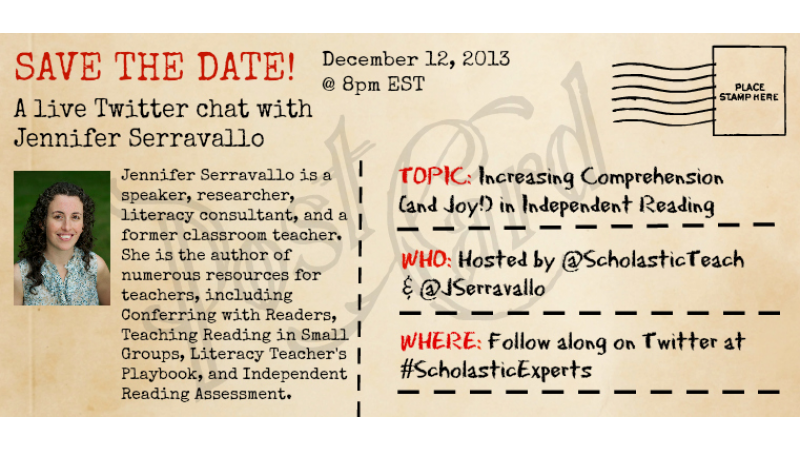 Are you looking for expert advice on student comprehension and independent reading? Look no further! On Thursday, December 12th at 8pm EST, Jennifer Serravallo (@JSerravallo) will be hosting a live Twitter chat with @ScholasticTeach. Be sure to follow the Twitter chat using #ScholasticExperts.
Are you looking for expert advice on student comprehension and independent reading? Look no further! On Thursday, December 12th at 8pm EST, Jennifer Serravallo (@JSerravallo) will be hosting a live Twitter chat with @ScholasticTeach. Be sure to follow the Twitter chat using #ScholasticExperts.
Jennifer is the author of a number of professional books including Independent Reading Assessment. Prior to becoming a literacy consultant, researcher, and author, Jennifer was a classroom teacher. While Jennifer gears up for the Twitter chat next week, check out this great Q&A she did with Instructor Magazine on independent reading:
How much independent reading time is appropriate at each grade level?
Your goal should be 30 minutes or more in kindergarten and the first grade and at least 40 minutes a day for second grade and up. That’s uninterrupted reading—not counting any mini-lesson you might teach. You could start the year with half that, or split the time into two periods. Teach strategies for building stamina (for example, students might place a Post-it several pages ahead and push to read to their goal before taking a break). And teach students strategies like rereading to get back on track. Tell them: No runner starts with a marathon. It all begins with a 15-minute jog!
How can I help my students gain confidence about picking the right books for themselves?
Give them lots of chances to succeed. Let kids know what their reading levels are, and make sure all books are marked by level. Organize some of your library bins by level and others by topic, such as “Cool Girl Characters” or “Gross Things” or “Wild Adventures.” When a student doesn’t like a book, encourage him to ask why. Is it too hard? Is the subject not interesting? Does he prefer something else—nonfiction or first-person narration or fantasy? Help students figure out their own preferences, and they’ll find more just-right books. And remember, when a kid seems fidgety and bored with a book, it might not be the subject matter but the difficulty. Make sure you’ve correctly assessed the level at which the student can read with a high degree of accuracy, fluency, and comprehension.
My administrator disagrees with setting aside time for silent reading during school. She wants us to assign independent reading for homework instead. What do you suggest?
Ideally, you should do both—have time in class and assign around 30 minutes of independent reading for homework. You might try sharing your strategies with your administrator. Explain that reading time also serves as instructional time during which you can work closely with students in small groups or individually to help them gain proficiency. Meanwhile, the rest of the class gets time to practice reading successfully.
Read the full article here: 10 Questions About Independent Reading
Don't forget to mark your calendar for Thursday, December 12th at 8pm EST, to join the live Twitter chat with @JSerravallo and @ScholasticTeach. And be sure to use #ScholasticExperts to follow the conversation.






